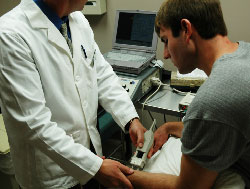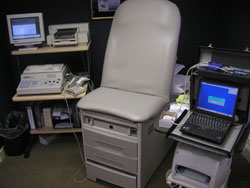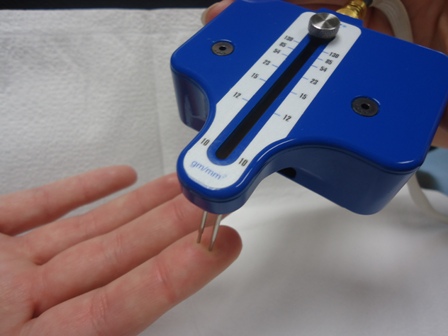Nerve Conduction Study Testing
Trust Your Hands With No Other!
Time is valuable to us all, so at the Carpal Tunnel Relief Center, a division of Nebraska Hand & Shoulder Institute, P.C., you will have an all-inclusive exam. A plan will be set up on your first visit to enable you to solve your carpal tunnel. A nerve conduction study (NCS) will be done on site in our office. No needles are required! The nerve conduction test will be explained thoroughly to you. This test is important to confirm a diagnosis and it helps to set a plan of action for relief of your condition.
Slow nerve conduction is associated with pain, numbness, grip loss and muscle wasting depending on how long it has been going on. If the compressed nerve is left unattended, the muscle will waste away (atrophy). If atrophy develops, loss of pinch strength and thumb motion may be permanent. Early treatment is recommended.
You have found the only hand specialist in Nebraska dedicated to the elimination of symptoms from nerve entrapment, and carpal tunnel in particular. Trust your hands with no other. It is simple. Having an all-inclusive exam, including the nerve conduction study, will tell you what's wrong, what can be done to help, and when. Many people travel from other states to get the nation's most successful results. We are as close as your airport.
Call today! 1-855-344-HAND (toll free) or 1-800-433-9147.

Painless Nerve Conduction Test
Electromyography (EMG) is a separate entity. EMG is more subjective than nerve conduction study (NCS). There remains a debate about which patients should be subjected to EMG. Dr. Ichtertz feels that right now this is an argument more to support the practice of special interest groups rather than a practical matter for the benefit of the patient. He believes EMG is most appropriately used in the setting of patients with atypical sensory or motor dysfunction patterns. Sensory disturbance in association with weakness, more likely referable to more than one nerve, brings out the need to separate peripheral nerve entrapment from a ruptured disk in the neck or lower back. This is particularly important when physical examination alone doesn't allow the distinction. EMG is also considered painful by many of the patients who undergo it, even though very tiny sterile needles are used.
This technique involves inserting the needles into muscles of the limb being tested. It is usually performed on both right and left sides for comparison while monitoring the response of the muscles on an oscilloscope. There is also monitoring for an audible noise pattern created by the muscle stimulation while the examiner stimulates the peripheral nerves. This sounds a lot like listening to a Geiger counter. The findings can be used to narrow down and confirm a diagnosis and it is most useful in patients with other than straightforward nerve entrapment syndromes. Therefore, it is generally not necessary in someone with carpal or cubital tunnel syndrome.

Onsite state-of-the-art digital nerve test equipment.
Pressure-Specific Sensory Device (PSSD)
In 2002 Dr. Ichtertz visited with A. Lee Dellon, M.D., Professor of Plastic Surgery and Neurosurgery at John Hopkins University Medical Center and author of over 250 scientific articles. The goal was to gain a full understanding of the technique and application of quantitative sensory examinations using the NMT Pressure-Specific Sensory Device (PSSD) which has been thoroughly developed and studied in the diagnosis of peripheral neuropathy – most specifically diabetic peripheral entrapment neuropathy. Dr. Ichtertz added this to his clinical armamentarium and has utilized the technology to further enhance the diagnosis and improve the treatment of ulnar nerve entrapment, both nonoperative and operative – specifically cubital tunnel syndrome. The results of this work are intended to be presented and published in the near future.

PSSD in use



